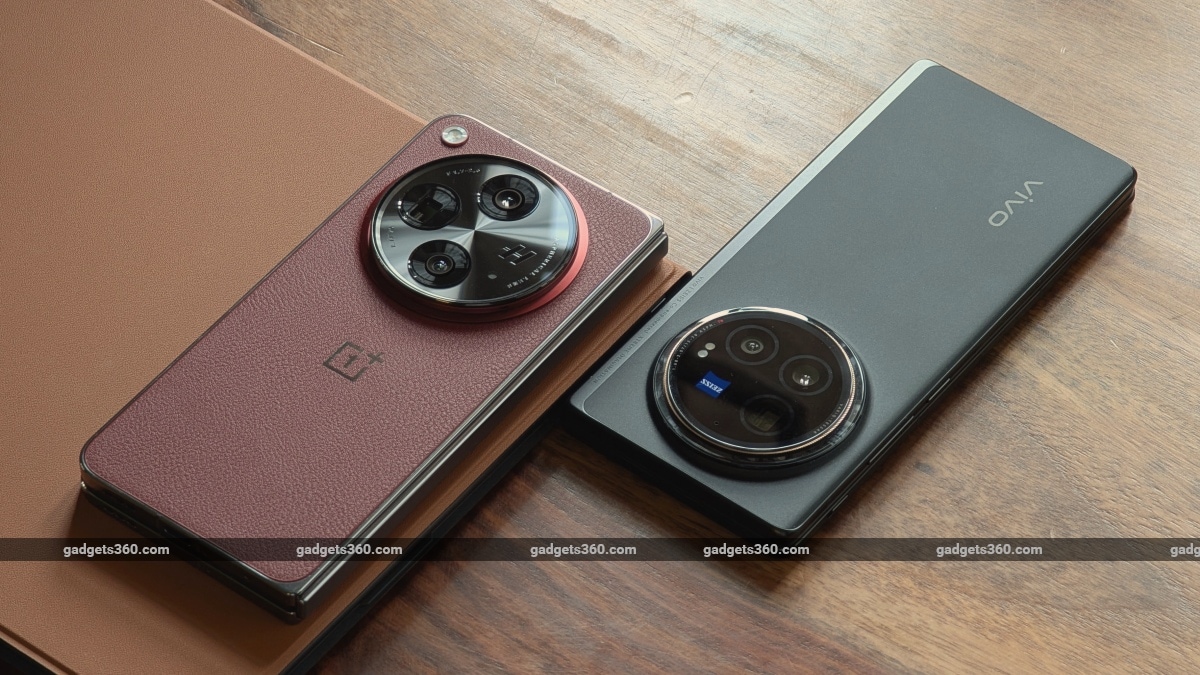Vivo X Fold 3 Pro vs OnePlus Open: Which One Should You Get?

Despite arriving rather late to the foldable party last year, OnePlus managed to make some waves when it announced its first foldable ever at a global launch event held in India. It was relatively slim and light when folded, but it also packed an excellent camera system (which was unheard of on foldable devices). Given that Samsung was still attempting to make its Galaxy Z Fold 5 thinner (it still appeared chunky), the Open was a very easy win for OnePlus. Add to this its lower launch price tag of Rs. 1,39,999 with a smooth and near flawless OxygenOS, and we ended up with an easy recommendation for those looking for a good balance of features at a palatable price tag.
Several months later, BBK sibling Vivo also decided to bring an existing model (previously launched in China) to India. With the Samsung Galaxy Z Fold 6 on the horizon, Vivo’s approach for its first foldable in India was a bit extreme in terms of design and price tag. Despite some flaws, the phone still managed to deliver the goods, and it did so quite well, as mentioned in my review.

The OnePlus Open’s vegan leather rear panel sure adds some character to its design apart from grip
When every millimetre counts
While OnePlus did raise the bar at launch, Vivo was quick to steal its crown when it came to design. The Vivo X Fold 3 Pro is slimmer (both open and folded) than the Open, but it’s also lighter. I also prefer its slightly tapered corners versus the Open’s sharp corners that poke into my palm when folded. It is, indeed, all about margins with the X Fold 3 Pro, and you can tell this by how incredibly delicate it looks when unfolded. Vivo even went to the extremes of curving one side of its cover screen display and the opposing rear panel so it does not feel as boxy as flat displays do (e.g. OnePlus and Samsung).

Both foldables offer alert sliders, but OnePlus has a three-stage one that is a lot easier to use because of its design
Despite taking extreme measures, the OnePlus Open comes out on top when it comes to one-handed usage. It’s not as slim as the Vivo X Fold 3 Pro, but its shorter cover display makes it more comfortable for one-handed use. Despite having a slightly narrower cover display (and folded design), the Vivo is quite tall and needs two hands to get things done. However, it is wide enough for doing anything and everything one would on a regular phone.

The Open’s display is compact, while the X Fold 3 Pro’s is taller
The main reason I was never confident while using the Vivo is down to its slippery glass design. The OnePlus Open (both in standard and Apex Edition models) has a grippy vegan leather rear panel, which gave me some added confidence while holding it.
Despite their similar book-style form factors, both models do feel quite different once you open up their main folding displays.
The OnePlus Open’s 7.82-inch inner display has a squarish aspect ratio, which is mainly useful when opening apps side-by-side. Vivo’s rectangular 8.03-inch display, thanks to its sheer size, handles both productivity and entertainment tasks well.

The software on both foldables can handle four apps at a time
Software matters
However, it’s not picture-perfect for Vivo in the software department. OnePlus surprisingly got everything from app scaling to its Open Canvas multi-tasking software right with Oxygen OS. This was impressive, given that it was the brand’s first foldable at launch. Everything from apps to games works perfectly fine and works well even when transitioning between displays.
Vivo, on the other hand, surprisingly came up short on execution. While I absolutely love the Desktop AOD mode on the Vivo, I noticed that apps did not stretch to fit the display when holding the foldable horizontally. This results in a black bar that plagues a majority of third-party apps, including many Google apps. With nearly a centimetre lost on the left side of the display because of this optimisation issue (which Vivo has yet to figure out), the software does feel quite unfinished even if it packs in many more software and hardware features over the Open. However, neither of these phones can stand up to Samsung’s Galaxy Z Fold 6 or Google’s Pixel 9 Pro Fold when it comes to AI tricks. Both OnePlus and Vivo are still a whole year behind Samsung and Google when it comes to integrating AI deep into their devices.

Months after launch, Vivo (right) has yet to figure out how to get rid of the black bar on the left, which eats into the space available on its large display
Neither foldable is slow in terms of performance. However, Vivo offers the latest Qualcomm Snapdragon 8 Gen 3 SoC, while OnePlus’s processor is a bit older, with a Snapdragon 8 Gen 2. Both phones offer 16GB of RAM and, so you will never face a hiccup when browsing through their respective skinned operating systems. One detail to note is that Vivo handles heat better, whether gaming, outdoor, or even camera. This is a bit surprising as it’s the thinner one of the two.
| Benchmarks | Vivo X Fold 3 Pro (Cover/Main) | OnePlus Open (Cover/Main) |
|---|---|---|
| AnTuTu v10 | 20,51,650 / 20,63,526 | 13,05,500 / 12,64,480 |
| PCMark Work 3.0 | 14,489 / 14,251 | 10,276 / 10,521 |
| Geekbench V6 Single | 2,143 / 2,167 | 1,426 / 1,056 |
| Geekbench V6 Multi | 6,562 / 6,800 | 4,096 / 4,114 |
| GFXB T-rex | 120 / 120 | 60 / 60 |
| GFXB Manhattan 3.1 | 120 / 105 | 60 / 60 |
| GFXB Car Chase | 102 / 67 | 60 / 46 |
| 3DM Slingshot Extreme OpenGL | Maxed Out / Maxed Out | Maxed Out / Maxed Out |
| 3DM Slingshot | Maxed Out / Maxed Out | Maxed Out / Maxed Out |
| 3DM Wild Life | Maxed Out / Maxed Out | Maxed Out / Maxed Out |
| 3DM Wild Life Unlimited | 17,985 / 18,721 | 13,913 / 13,731 |

Vivo’s X Fold 3 Pro is currently the only foldable in India to offer not one but two in-display fingerprint readers
It’s always about the cameras
As with every smartphone (foldable or not) available today, a lot depends on its camera performance. Nobody wants to invest in a smartphone costing well over a lakh only to carry a second flagship phone just for shooting photos and recording videos.
Daylight camera samples (tap image to expand)
Despite both cameras punching well above the norm, I have to conclude that Vivo manages to do a better job with photos than OnePlus. Its photos from the primary and telephoto cameras (both OIS stabilised) come out sharper, have good detail, and have impressive colour reproduction. The OnePlus Open loses out to the Vivo X Fold 3 Pro when it comes to dynamic range and colour reproduction. I have noticed many times that the telephoto camera is a bit unreliable in the sense that photos have a warmer white balance, which results in yellowish tones. Vivo’s telephoto camera also handled moving subjects better, resulting in sharper photos when capturing kids or pets. In low light, Vivo once again manages better dynamic range, showing more detail in the darker areas of an image.
Low light camera samples (tap images to expand)
Vivo’s ultrawide camera did have some white balance consistency issues during our review, but these seem to be resolved with software updates. In terms of quality, both ultrawide cameras offer similar performance.
Selfie camera samples (tap images to expand)
The OnePlus Open’s video recording capabilities are better than those of the X Fold 3 Pro. The phone manages better dynamic range (revealing more details in the shadows), offers better noise, and has a steadier frame rate.
Battery life is no longer a touchy topic
Battery life is another area where people don’t expect any compromises, and here’s where Vivo delivers better than OnePlus. While the OnePlus Open will get you a whole day of heavy usage, Vivo one-ups this by easily managing a day and a half of heavy usage, which is nearly as good as a regular premium smartphone. The X Fold 3 Pro is also a lot faster at charging its larger 5,700mAh battery, going from 0-100 percent in just 43 minutes. The Open is a bit slower to charge its smaller 4,805mAh battery, managing a full charge in 53 minutes. Vivo also offers 50W wireless charging, which the OnePlus does not, and I’m sure this may be a deal breaker for some.

The Vivo X Fold 3 Pro (right) is thinner than the competition but still offers 50W wireless charging
What makes each one so special
Samsung’s Galaxy Z Fold 6, despite banking heavily on AI this year, will still be the go-to foldable for many because they have been around since the very first model was launched in India. But for those willing to try something new, Vivo’s X Fold 3 Pro offers better value despite its higher price tag of Rs. 1,59,999. It’s foldable to pick if you are looking for a device that can compete with regular, bar-shaped Android flagships, especially when it comes to still imaging and battery life. It also offers the biggest and widest display possible on a foldable today. So, it’s also good if you plan to get some light work done (with a Bluetooth keyboard) while on the move.
Given its more accessible price tag, which starts from Rs. 1,39,999, the OnePlus Open will remain the foldable of choice for those who want to try out the folding form factor for the very first time. More accessible pricing aside, OnePlus also offers an extended warranty called OnePlus Care (which Vivo does not), and this should give any buyer who is clumsy or worried about breaking their foldable’s display more confidence when investing in a foldable.




